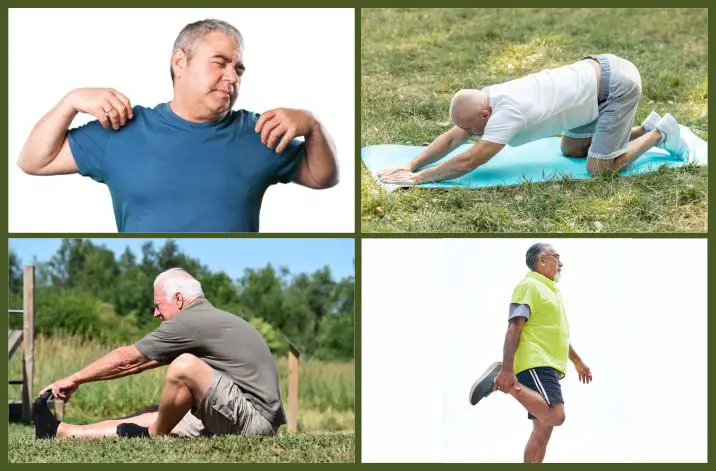Last updated on April 28th, 2025 at 11:17 am
Struggling with stiffness or poor balance? Discover flexibility and balance exercises for older men that improve mobility, prevent falls, and help you stay active, steady, and independent as you age.
Maintaining flexibility and balance as you age becomes increasingly important for overall health and independence.
Aging naturally brings changes like reduced muscle mass, decreased bone density, and limited joint mobility, all of which can affect daily life.
Flexibility and balance exercises are important for preventing falls, improving mobility, and maintaining independence.
Not only do these exercises help enhance physical function, but they also reduce the risk of chronic conditions, promote cardiovascular health, and boost mental well-being.
This guide is tailored specifically for older men who want to improve flexibility and balance through safe, simple exercises.
Whether you’re new to fitness or have limitations, these routines are adaptable to your needs.
By incorporating flexibility, balance, and strength exercises, older men can improve coordination and mobility, staying steady, active, and independent as they age.
Recommended: Fitness for Older Men to Remain Up and About
Table of Contents
- Main Points
- What are Flexibility and Balance Exercises?
- How My Dad Beat Stiffness and Embraced Flexibility
- Benefits of Flexibility and Balance Exercises for Older Men
- Best Flexibility Exercises for Men Over 50
- Best Balance Exercises for Older Men
- How to Start a Safe Routine
- Tips for Staying Consistent
- When to Seek Help
- Frequently Asked Questions
- Conclusion
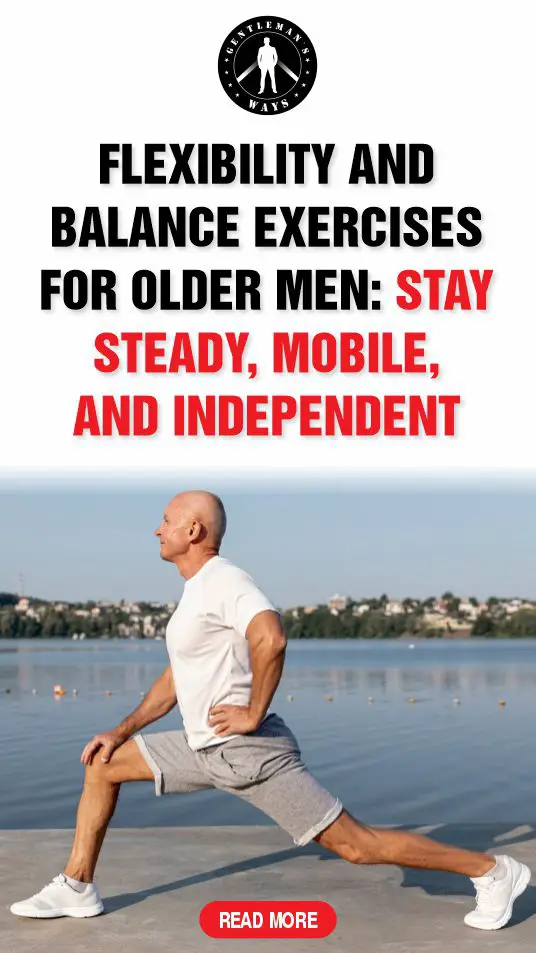
Main Points
- Flexibility and balance exercises are essential for older men to improve mobility, prevent falls, and maintain independence as they age.
- Incorporating flexibility exercises reduces stiffness, improves joint health, and enhances daily activities like bending, reaching, and walking.
- Balance exercises, like single-leg stands and heel-to-toe walks, help strengthen stabilizer muscles and improve coordination, reducing fall risks.
- Tai Chi, yoga, and chair squats enhance strength, balance, and flexibility, contributing to better overall health and mobility for older men.
Related: Functional Fitness for Older Men
What are Flexibility and Balance Exercises?
Flexibility exercises are physical activities aimed at increasing the range of motion in the muscles and joints. These exercises involve stretching movements that help lengthen muscles and improve their elasticity, which enhances overall mobility and reduces the risk of injuries.
Balance exercises are activities designed to improve an individual’s ability to maintain stability and control while standing or moving. These exercises strengthen the core and lower body muscles, enhance coordination, and help improve posture, which is essential for preventing falls and maintaining functional stability in daily activities.
Recommended Posts
- Healthy and fun hobbies for men over 50
- Strength and Resistance Training for Men Over 50
- Cardio Workouts Every Older Man Should Embrace
- Men’s Health and Wellness
How My Dad Beat Stiffness and Embraced Flexibility
When my dad was in his 70s, he made flexibility exercises a daily part of his routine.
Despite knowing that his body wasn’t as strong as it once was, he was determined to stay active.
He would join us during our exercise sessions, carefully selecting the routines that suited his age and limitations.
His favorite was a series of gentle stretches and balance exercises that kept him mobile and helped him avoid falls.
He was always mindful of his fragility, taking the time to assess the safety of any activity before jumping in.
There was never a day where he didn’t do something, whether it was stretching his legs or practicing his balance.
His commitment to staying active ensured that he could keep up with daily tasks like gardening, walking to the store, and playing with the grandkids, all while avoiding movements that might put him at risk.
His example showed us how the right flexibility exercises can make a huge difference in maintaining independence and mobility well into our later years.
Benefits of Flexibility and Balance Exercises for Older Men
As your age accumulates, your body naturally changes. Muscle elasticity and coordination decline, which can make it harder to move freely and maintain independence.
But the good news is, that flexibility and balance exercises for older men can help you stay active, mobile, and steady.
- Improved Daily Activities: Flexibility exercises make bending, reaching, and other daily tasks easier, helping you maintain independence as you age by improving your overall mobility and comfort.
- Fall Prevention: Balance exercises reduce the risk of falls, a major concern for older men, keeping you steady and preventing serious injuries that could impact your independence.
- Better Posture and Joint Health: Flexibility training helps lengthen tight muscles and supports joint function, relieving strain on your spine and joints, and enabling you to stay active longer.
- Boosting Mental Health: Regular flexibility and balance exercises increase confidence and reduce anxiety, making you feel more empowered to stay active, engaged, and focused on your well-being.
- Boosting Confidence: Flexibility exercises boost older men’s confidence by improving posture, mobility, and self-assurance, benefits that extend beyond daily life into dating. Stay fit, feel good, and date with confidence.
Best Flexibility Exercises for Men Over 50
These exercises help reduce stiffness, improve range of motion, and support overall well-being.
Here are some of the best flexibility exercises for you as a man over 50 to incorporate into your routine to reduce stiffness, improve range of motion, and support overall physical health:
1. Neck and Shoulder Rolls
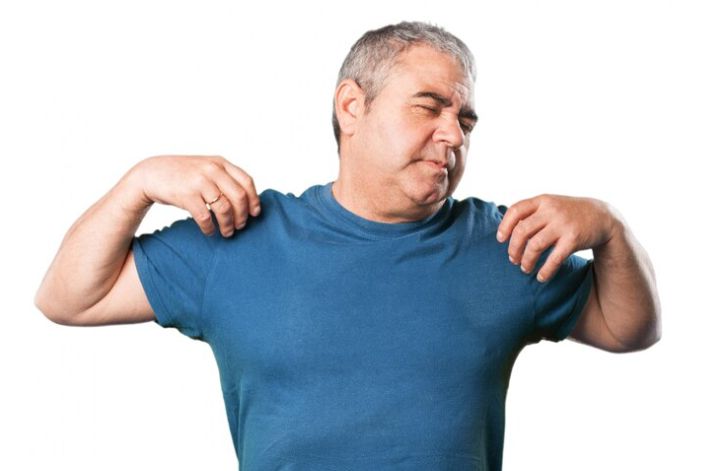
Sit or stand comfortably and slowly roll your shoulders forward in a circular motion for five repetitions, then reverse the direction.
Afterward, tilt your head towards one shoulder, hold for a few seconds, and repeat on the other side.
This simple exercise relieves tension in your neck and shoulders, which is common as you age.
It helps with flexibility, especially if you spend a lot of time sitting or working at a desk. Doing this regularly can prevent stiffness and improve overall mobility.
Remember to breathe deeply as you move to maximize the stretch and reduce any discomfort.
This exercise is easy to add to your daily routine and doesn’t require special equipment.
2. Seated Hamstring Stretches
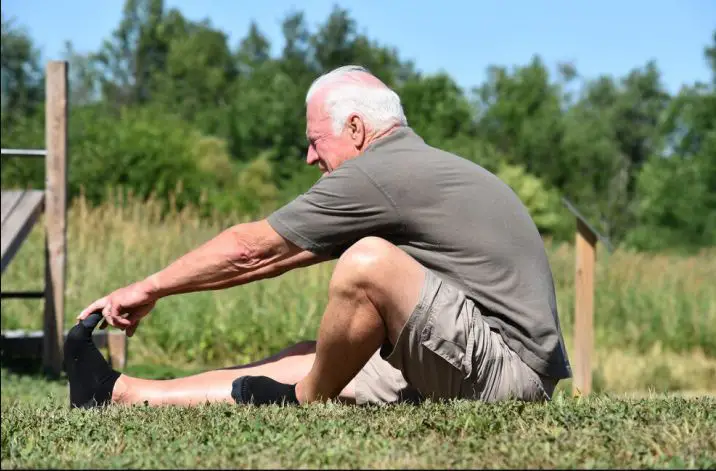
Sit on the edge of a sturdy chair or bench with your legs extended in front of you. Keep your back straight and slowly reach toward your toes while taking deep breaths.
Hold the stretch for 15-30 seconds. This exercise targets the hamstrings, which can tighten with age, and helps maintain flexibility in your lower body.
If you can’t reach your toes initially, feel free to bend your knees slightly. As you keep doing the stretch, you’ll notice your range of motion improving.
It’s a simple but effective way to keep your legs flexible and prevent stiffness. Perform this stretch regularly to maintain flexibility and mobility in your legs.
3. Standing Calf Stretches
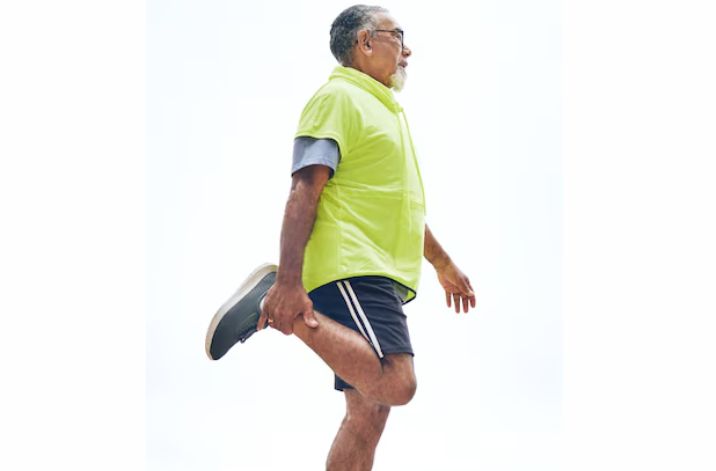
To do this stretch, stand facing a wall with your hands flat against it at shoulder height. Step one foot back, keeping it straight, and bend the other knee slightly.
Press the heel of the straight leg into the ground until you feel a stretch in your calf. Hold for 15-30 seconds, then switch sides.
This exercise targets the calves, which can become tight over time and affect your balance. By regularly stretching your calves, you improve both flexibility and stability.
Calf stretches are essential for maintaining mobility and balance, especially if you enjoy walking or other lower-body activities.
Remember to do this exercise slowly and with control for the best results.
4. Cat-Cow Stretches
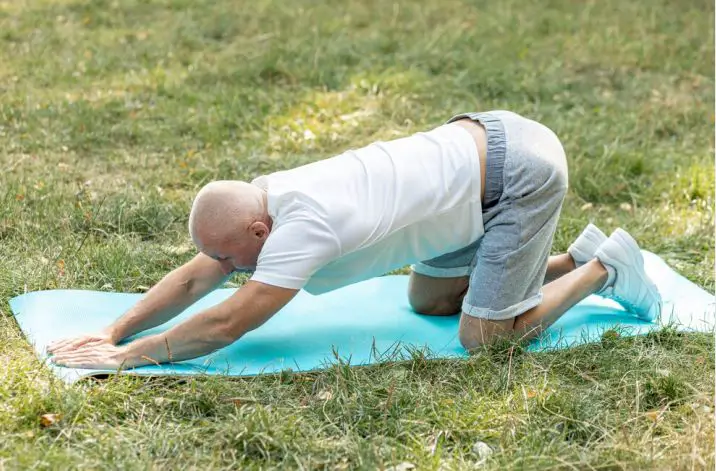
Start on all fours on a comfortable surface, with your hands directly under your shoulders and knees under your hips.
As you inhale, arch your back, lifting your head and tailbone (cow position). On the exhale, round your back and tuck your chin and tailbone (cat position).
Repeat this for five cycles to promote flexibility in your spine. This exercise enhances spinal mobility, which can improve posture and relieve back discomfort.
Doing the Cat-Cow stretch regularly can also prevent stiffness in your lower back and neck.
It’s a simple way to promote overall flexibility in your torso, which is key to maintaining a healthy, active lifestyle.
5. Chest Openers
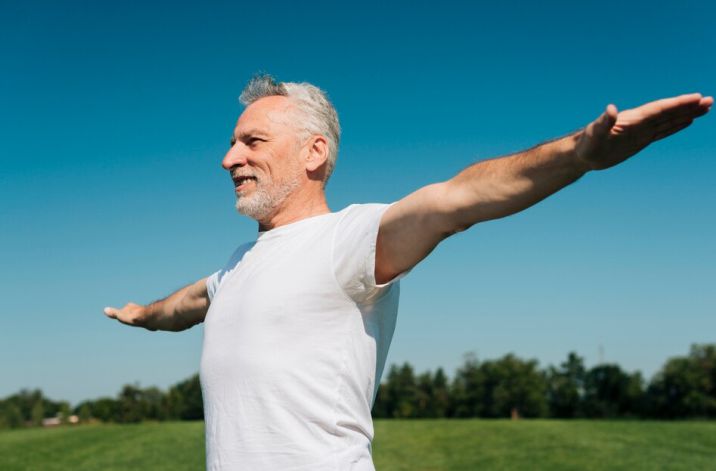
Stand tall with your feet shoulder-width apart. Interlace your fingers behind your back and gently pull your shoulders back while lifting your arms slightly.
Hold for 15-30 seconds. This exercise opens up the chest and stretches the shoulders, which is especially helpful if you’ve noticed a forward-leaning posture as you age.
Chest openers counteract the hunched posture that can develop with age, improving overall posture and reducing back and neck pain.
This simple stretch helps you feel more aligned and balanced in your movements.
Regular chest opening exercises will support your upper body and enhance your overall flexibility. Practice this stretch daily for lasting benefits.
Best Balance Exercises for Older Men
Maintaining balance is needed for older men to help themselves with mobility and reduce the risk of falls.
Incorporating specific balance exercises into your routine can improve stability and coordination.
Here are some effective balance exercises that can easily be performed at home or in a safe environment:
1. Single-Leg Stands
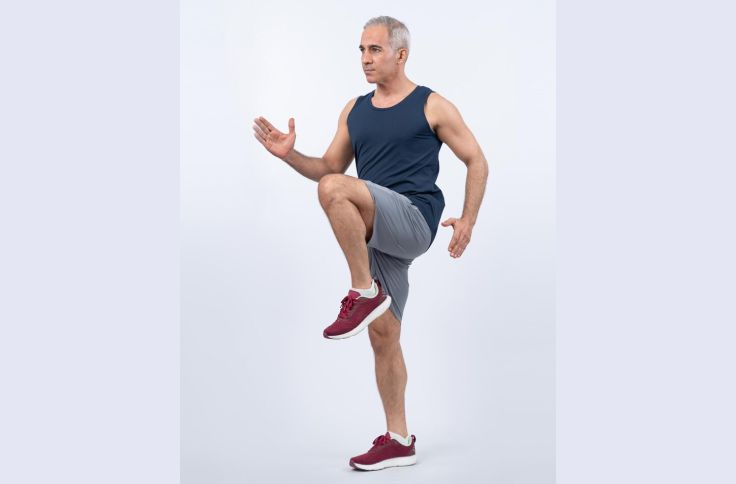
Single-leg stands are a simple yet powerful exercise to improve balance and stability.
To start, stand with your feet shoulder-width apart and lift one foot slightly off the ground, aiming for a few inches of clearance.
Try to hold this position for up to 30 seconds, focusing on keeping your body still. Once you feel comfortable, switch to the other leg.
For an added challenge, close your eyes while holding the position. This forces your body to rely on proprioception, improving balance without visual cues.
Regular practice helps strengthen the stabilizer muscles in your ankles, knees, and hips, which are essential for maintaining balance and preventing falls.
This exercise can be done anywhere, making it a convenient addition to any routine.
2. Heel-to-Toe Walk
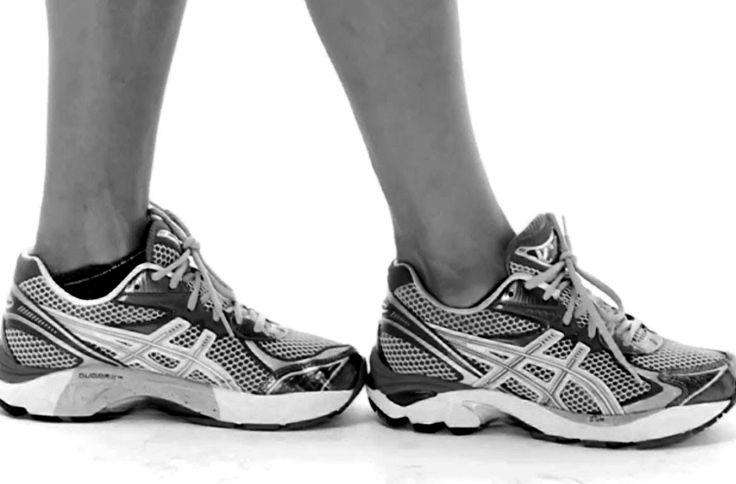
The Heel-to-Toe walk is a great way to improve coordination and balance. Start by finding a straight line or imagine one on the floor.
Begin walking forward by placing the heel of one foot directly in front of the toes of the other foot. Keep your head straight and your gaze forward to maintain your posture.
Focus on slow, controlled steps as you walk 10 to 20 steps forward, then turn around and repeat.
The key is to stay as steady as possible with each step while engaging your core muscles.
This exercise mimics walking on a tightrope, which forces you to improve your balance, stability, and coordination.
It can be done indoors or outdoors and offers an easy way to challenge your balance.
3. Side Leg Raises
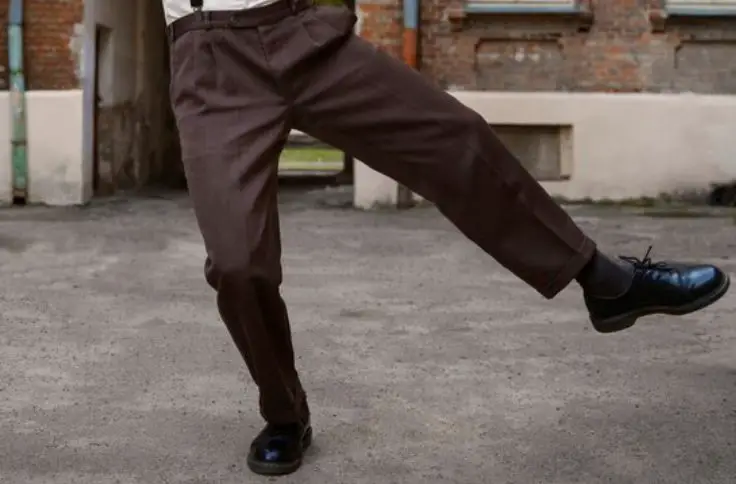
Side leg raises are excellent for building strength in the hip muscles, which are crucial for maintaining balance.
To perform this exercise, stand beside a sturdy support like a chair or wall. Keep your back straight and engage your core as you slowly lift one leg to the side.
Make sure your leg stays straight and your body doesn’t lean over to compensate.
Hold the position for a few seconds before gently lowering your leg back down. Perform 10 repetitions on each leg.
This exercise targets the abductors, the muscles that help stabilize your pelvis when walking.
Strengthening these muscles can help prevent falls and enhance your overall balance. For additional challenges, you can add ankle weights once you’re comfortable with the movement.
4. Chair Squats
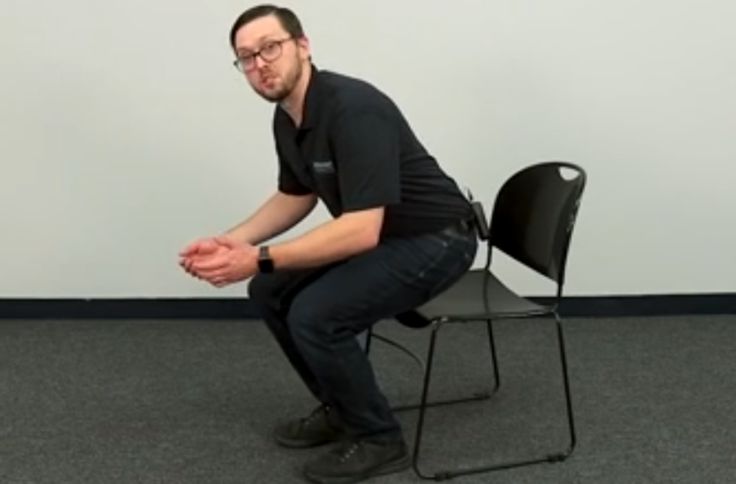
Chair squats are an effective way to build strength in your legs, particularly your quads and glutes, which are vital for maintaining stability and balance.
Start by standing in front of a sturdy chair with your feet shoulder-width apart. Slowly bend your knees and lower your body as if you’re about to sit down.
Stop just before you touch the chair and hold for a second or two before rising back to a standing position. Repeat this motion 8 to 10 times.
Focus on keeping your back straight and your knees aligned with your toes throughout the movement.
Chair squats help improve both strength and mobility in the lower body, which directly supports your ability to balance and perform everyday activities, such as standing up from a seated position.
5. Tai Chi or Yoga Poses
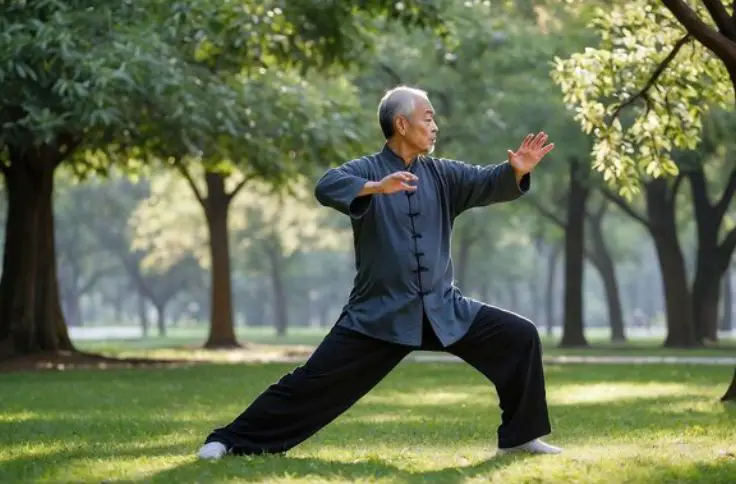
Tai Chi and yoga are both excellent practices for improving balance, flexibility, and mental well-being.
For older men, the slow, controlled movements of Tai Chi are ideal for developing stability.
Poses like the Tree Pose in yoga or the Warrior Pose can improve both strength and balance.
These exercises encourage mindfulness and focus, which help calm the mind while strengthening the body.
To begin, consider joining a class tailored for older adults or use online resources to guide you through poses at your own pace.
Regular practice of Tai Chi or yoga helps improve posture, coordination, and mobility, all of which contribute to better balance and fewer falls.
With consistent effort, these exercises can support long-term stability and overall health.
Integrating these exercises into daily routines not only boosts physical strength but also enhances mind-body connection, leading to improved overall balance and confidence in mobility.
Starting slowly and gradually increasing the difficulty will yield the best results.
How to Start a Safe Routine
Starting a flexibility and balance routine is key to maintaining your mobility, stability, and independence as you age.
A safe approach ensures you get the most out of your workouts while preventing injury. Here’s how you can begin:
Set a Consistent Schedule
Aim to do flexibility and balance exercises two to three times a week. This schedule allows for recovery between sessions while providing enough repetition to see progress.
Balance exercises should gradually challenge your coordination while stretching routines will help improve flexibility over time.
Warm Up Before You Start
Before you jump into your routine, warm up properly to prepare your body. A simple 5 to 10-minute walk or marching in place is enough to get your blood flowing and loosen up your muscles.
This reduces the risk of injury by ensuring your body is ready for more demanding exercises.
Cool Down After Your Session
After your workout, always take time to cool down. Spend another 5 to 10 minutes stretching gently to relax the muscles you worked during your routine.
This helps your muscles recover and can prevent tightness or soreness the next day.
Start with Simple Exercises
When you first begin, choose easy exercises that target flexibility and balance. Simple stretches and basic balance movements will help you build a strong foundation.
As you become more comfortable, you can gradually increase the difficulty of your exercises.
Progress at Your Own Pace
Listen to your body. If a movement feels uncomfortable or painful, stop and modify the exercise.
Don’t rush the process. Track your progress so you know when to challenge yourself further or when to take it easy.
Optional Tools for Support
To make your routine more effective, you can add tools like resistance bands or balance boards.
These tools provide extra support while helping you strengthen muscles and improve stability.
Resistance bands can make stretches more challenging, while balance boards help improve core strength and overall balance.
With these steps, you’ll be on your way to a safe and effective flexibility and balance routine that improves your quality of life.
Stay consistent, listen to your body, and gradually increase the intensity of your workouts to get the best results.
Tips for Staying Consistent
Staying consistent with your exercise routine is key to improving flexibility and balance as you age. Here are a few strategies to help you stick with it:
- Set Realistic Goals: Start with small, achievable goals. Focus on consistency with 10-15 minutes of flexibility exercises each day.
- Track Your Progress: Use a journal or app to monitor workouts. Celebrate small wins to stay motivated and focused.
- Add Variety to Your Routine: Change exercises regularly. Try classes for structure, community, and new challenges that keep things engaging.
- Stay Motivated: Set a regular workout time. Involve friends or family and remind yourself of the benefits for consistency.
When to Seek Help
Flexibility and balance exercises are great for your mobility, independence, and health. However, there are times when you need to seek help.
If you feel consistent pain during exercises, get lightheaded, or frequently lose balance during daily activities, it’s a sign you might need professional advice.
If you have health conditions like arthritis, chronic pain, or heart issues, it’s important to consult a doctor or physical therapist before starting a routine.
They can give you personalized recommendations based on your abilities and limits.
Certain medications can also affect your balance and coordination, so it’s wise to check how they might interact with exercise.
If dizziness or balance issues are triggered by movements, it’s best to get checked for inner ear problems or other conditions.
A healthcare professional can guide you on how to safely continue your exercises.
By recognizing when to ask for help, you ensure that your exercise routine remains safe, effective, and tailored to your needs.
Frequently Asked Questions
Why is balance important for older men?
Balance is essential for older men to prevent falls, maintain mobility, and enhance coordination, reducing the risk of injuries and ensuring greater independence in daily activities.
How often should older men do flexibility exercises?
Older men should aim to perform flexibility exercises at least two to three times a week, ensuring consistency while allowing time for recovery and progress in mobility.
Can flexibility exercises reduce joint pain in older men?
Yes, flexibility exercises help improve joint mobility, reduce stiffness, and alleviate discomfort caused by muscle tightness, making it easier for older men to stay active and reduce joint pain.
What are the best balance exercises for older men?
Single-leg stands, heel-to-toe walks, and side-leg raises are excellent balance exercises that improve stability, and coordination, and reduce the risk of falls, especially when practiced regularly.
How can older men safely start a flexibility and balance routine?
Older men should start with simple exercises, gradually increasing intensity. Warm-up and cool-down routines are essential, and seeking professional advice is recommended for those with health concerns or limitations.
Conclusion
Flexibility and balance exercises for older men are important to maintain mobility, prevent falls, and preserve independence.
As aging naturally leads to reduced flexibility and coordination, engaging in these exercises offers numerous benefits, such as improved posture, enhanced joint health, and better mental well-being.
By incorporating simple stretches, balance exercises like single-leg stands, and practices such as Tai Chi or yoga, older men can significantly reduce the risks associated with aging, including falls and limited mobility.
Starting slowly, progressing at a comfortable pace, and staying consistent is key to achieving lasting improvements.
Remember, if any discomfort or balance issues arise, it’s important to seek guidance from a healthcare professional to ensure a safe and effective exercise routine tailored to individual needs.
Are you pleased with this information, please reach out to us with your views and thoughts. We love to hear from you.
References
- The Best Balance Exercises to Do As You Age
- Best Balance Exercises for Seniors
- International Exercise Recommendations in Older Adults
- Flexibility Training and Functional Ability in Older Adults: A Systematic Review
Pyo Merez is a men’s lifestyle enthusiast and writer about the gentleman’s place and impact on society. Raised by a distinguished gentleman dad, he offers unique insights into how the mind of a gentleman works and how societal norms shape gentlemen’s identity and vice versa.
Through his insightful articles, Pyo taps into the depths of gentleman culture to provide perspectives on etiquette and manners in modern society.

